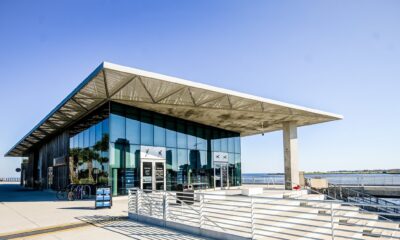Thrive
Will Rays stadium redevelopment revisions secure ‘yes’ votes?

Mayor Ken Welch noted that St. Petersburg sits on the precipice of a “historic opportunity” Tuesday morning.
Just over four hours later, after a final workshop concerning the largest project in city history, Welch expressed confidence in the iterative process leading up to that moment. The city council will vote on several agreements Thursday related to the Historic Gas Plant District and Tropicana Field’s $6.7 billion redevelopment.
The meeting provided a final opportunity for city officials and the development team – led by the Tampa Bay Rays and Hines – to discuss contractual revisions. Welch, who previously articulated his desire to “earn every vote,” noted that several council members “thanked us for incorporating their recommendations” Tuesday.
“I feel really positive about where we are now,” Welch told the Catalyst. “And I’m looking forward to the conversation on Thursday.”

An aerial rendering of the Historic Gas Plant District’s redevelopment, anchored by a new Tampa Bay Rays stadium (right). Images provided.
The council’s tenor has gradually improved throughout the three workshops, which began in May. In what was likely a bellwether for final agreements, the council passed multiple foundational measures related to the 30-year project by a 5-3 vote in June.
Councilmembers Richie Floyd, John Muhammad and Lisset Hanewicz opposed each initiative. While appreciative of specific development agreement alterations, the trio offered pointed concerns again Tuesday.
After the meeting, Floyd noted the public contribution to the $1.37 billion ballpark and surrounding infrastructure remains unchanged. St. Petersburg will finance most of its $287.5 million capped subsidy through a bond issuance, which it will repay through tax increment financing revenue generated from increasing downtown property values.
Pinellas County would own the stadium site and spend $312.5 million in tourism tax dollars. Welch has noted that the city is paying just 21% of the generational project’s tab, the county 23% and the Rays must cover the remaining 56% and any cost overruns.
“That’s where my main contention is at,” Floyd said. “We’re about to dump a huge amount of taxpayer money – the biggest in the city’s history and the biggest ever in MLB (Major League Baseball) history – into a private corporation.”
During the meeting, Floyd expressed concern that administrators would further subsidize the project’s 1,200 affordable and workforce housing units. While administrators routinely provide additional gap financing for those developments, Councilmember Copley Gerdes said city officials could rebuff those requests due to the discounted land sale.
Council Chair Deborah Figgs Sanders stressed the importance of honoring Gas Plant descendants and questioned efforts to properly inter human remains potentially buried at the site. Brian Caper, economic and workforce development director, said ground-penetrating radar has identified four “disturbances.”
He explained that those “could be anything” and occur around the outermost edge of the redevelopment site. Caper said crews will expand efforts to include the surrounding area this week, and he expects to provide a complete report this fall.

City council members will vote on the 30-year project Thursday.
Councilmember Gina Driscoll said the barbed wire-topped fence along the I-175 overpass resembles a prison yard. She called it “offensive” as it welcomed residents of neighboring Campbell Park into a vibrant new mixed-use community
While the U.S. Department of Transportation controls the interstate, Driscoll said the 16th Street South underpass “isn’t much better.” Rays president Brian Auld said the developers are eager to improve those connections.
Everald Colas, founder of St. Pete-based Storyn Studio for Architecture, said the development team plans to transform the blighted underpass into a lighted amenity. Previously unreleased renderings showcased market space, gardens and artwork.
Gas Plant descendants told Colas that two churches once stood at the site. He said the developers could incorporate that history into the pocket gardens.
“This is really amazing,” Driscoll said. “This is exactly what I was looking for.”
Councilmember Brandi Gabbard credited the development team for assuaging several environmental resiliency concerns. She prioritized those aspects and a grocer’s inclusion in the minimum rather than target development requirements.
However, Gabbard questioned why its mandated size decreased from 20,000 to 10,000 square feet in the revised documents. Michael Harrison, senior managing director for Hines, said the goal is to provide a larger facility. He added that grocery corporations require extensive demographic data before committing to a location and realize a Publix is just over a mile away.
“I’m very happy about the first interim development milestone,” Gabbard said of the new requirement to complete 400,000 square feet of vertical construction by Dec. 31, 2030. “I’m also very happy with the many, many layers of city council approvals.”

A rendering of a reimagined pocket park around the 16th Street South underpass. Screengrab, city documents.
Gabbard and several colleagues expressed dismay that new state legislation prohibits the city from mandating apprenticeship and disadvantaged worker requirements. Rays and Hines officials pledged to “act in good faith” to achieve those goals.
Figgs-Sanders asked how city officials could ensure those efforts without violating the law. Assistant City Attorney Michael Dema said annual community benefit updates would serve as a reporting mechanism.
After the meeting, Auld said the development team put their “best foot forward today.” However, he noted that the Rays have pursued a new stadium for over a decade, and the team “won’t be counting any chickens until they hatch.”
“I was really pleased with and proud of the way our experts handled a lot of challenging questions from really well-informed city council members,” Auld added. “From what I could tell, we put their minds at ease about a number of their biggest concerns. So, obviously, we feel good about that.”








Ryan Todd
July 17, 2024at6:11 pm
I miss how development deals were handled in Kandahar City.